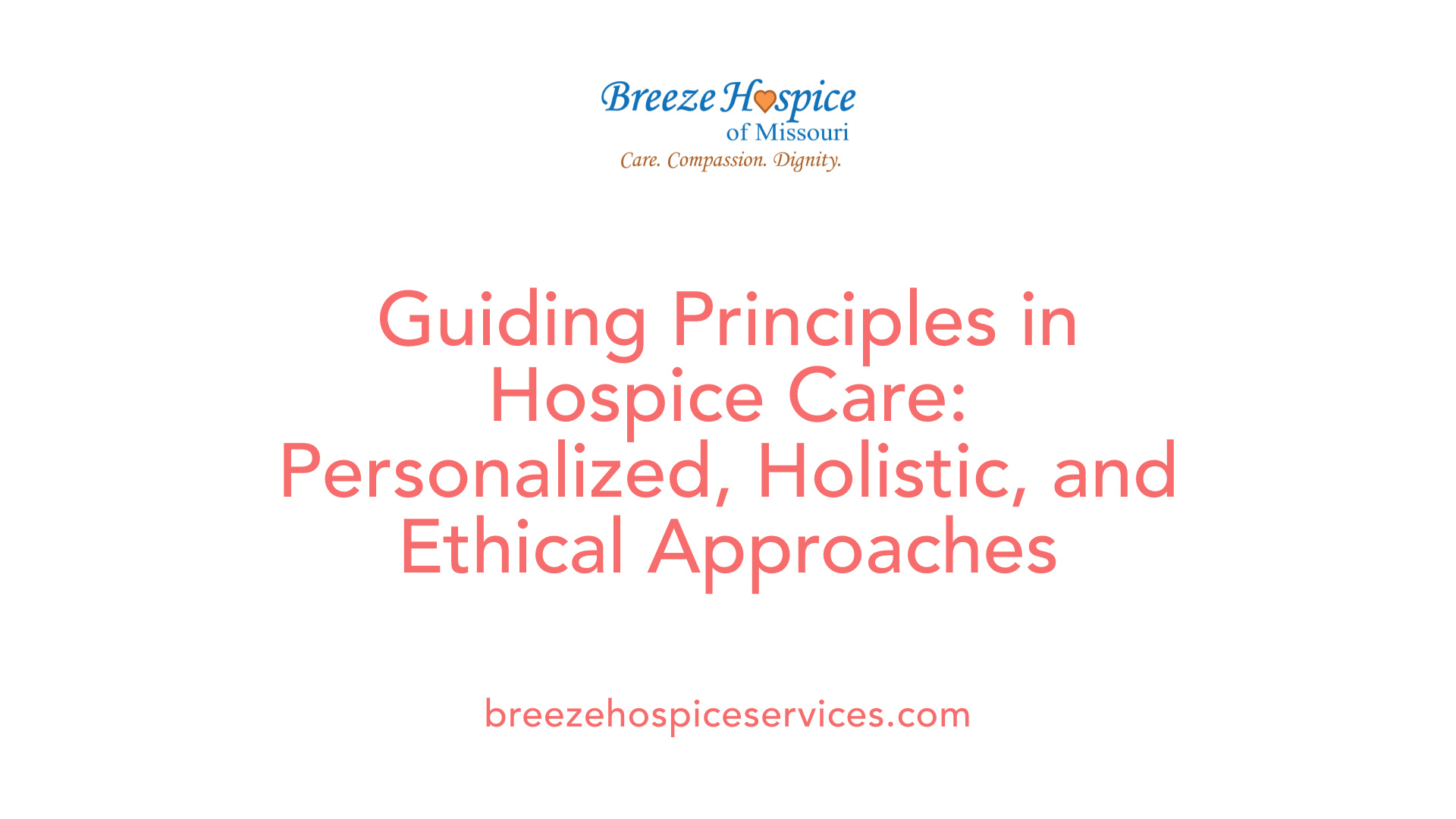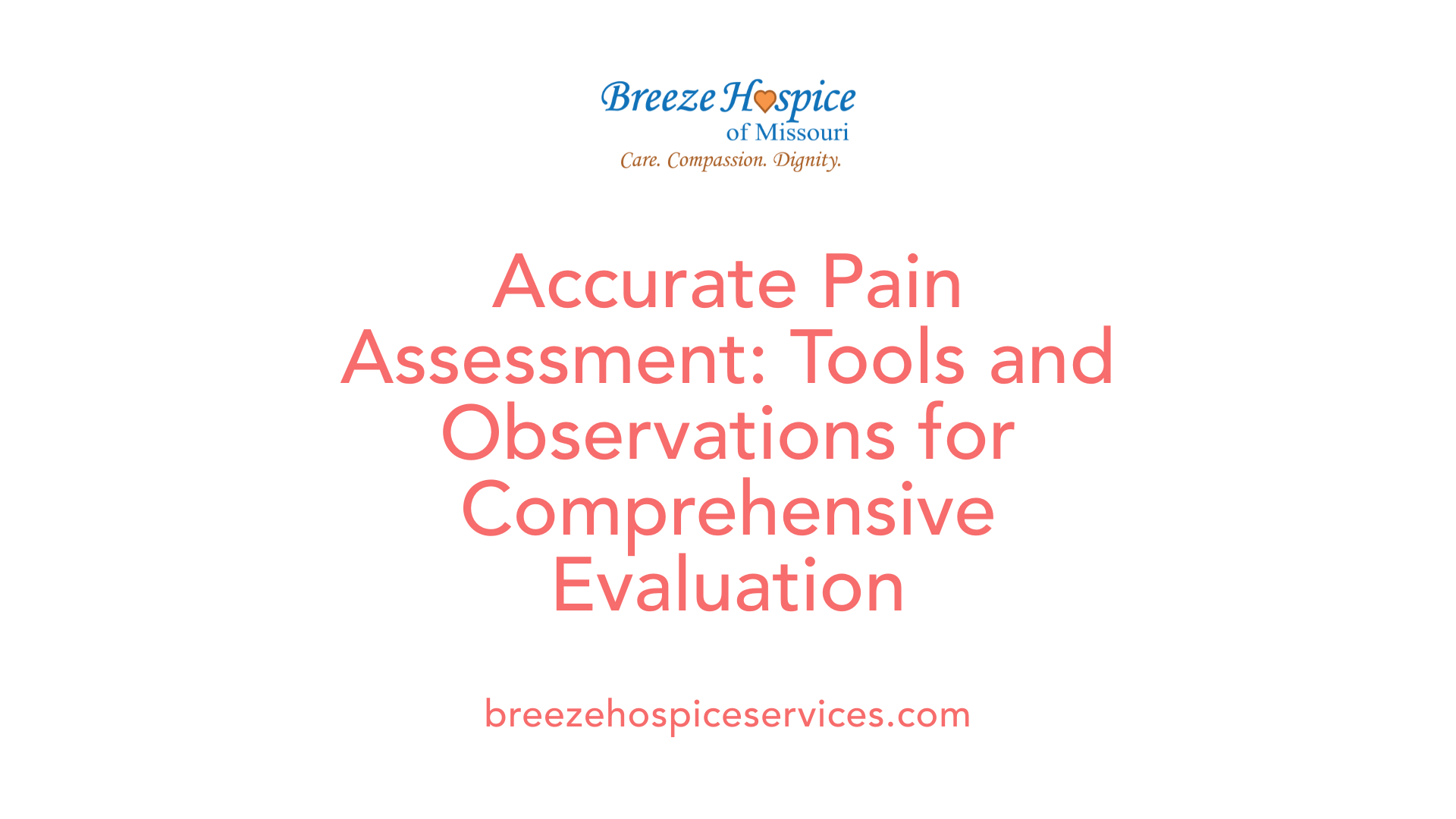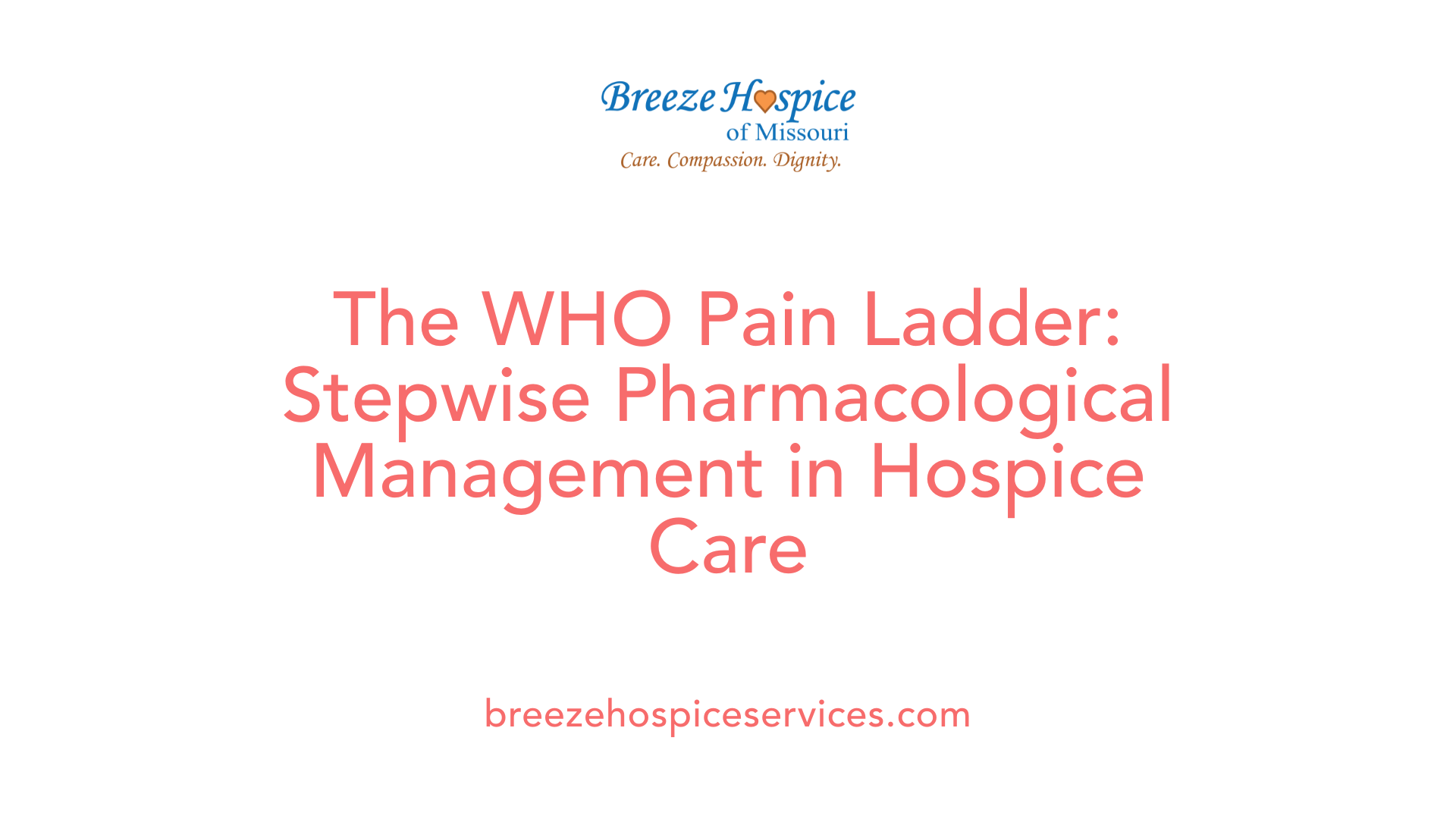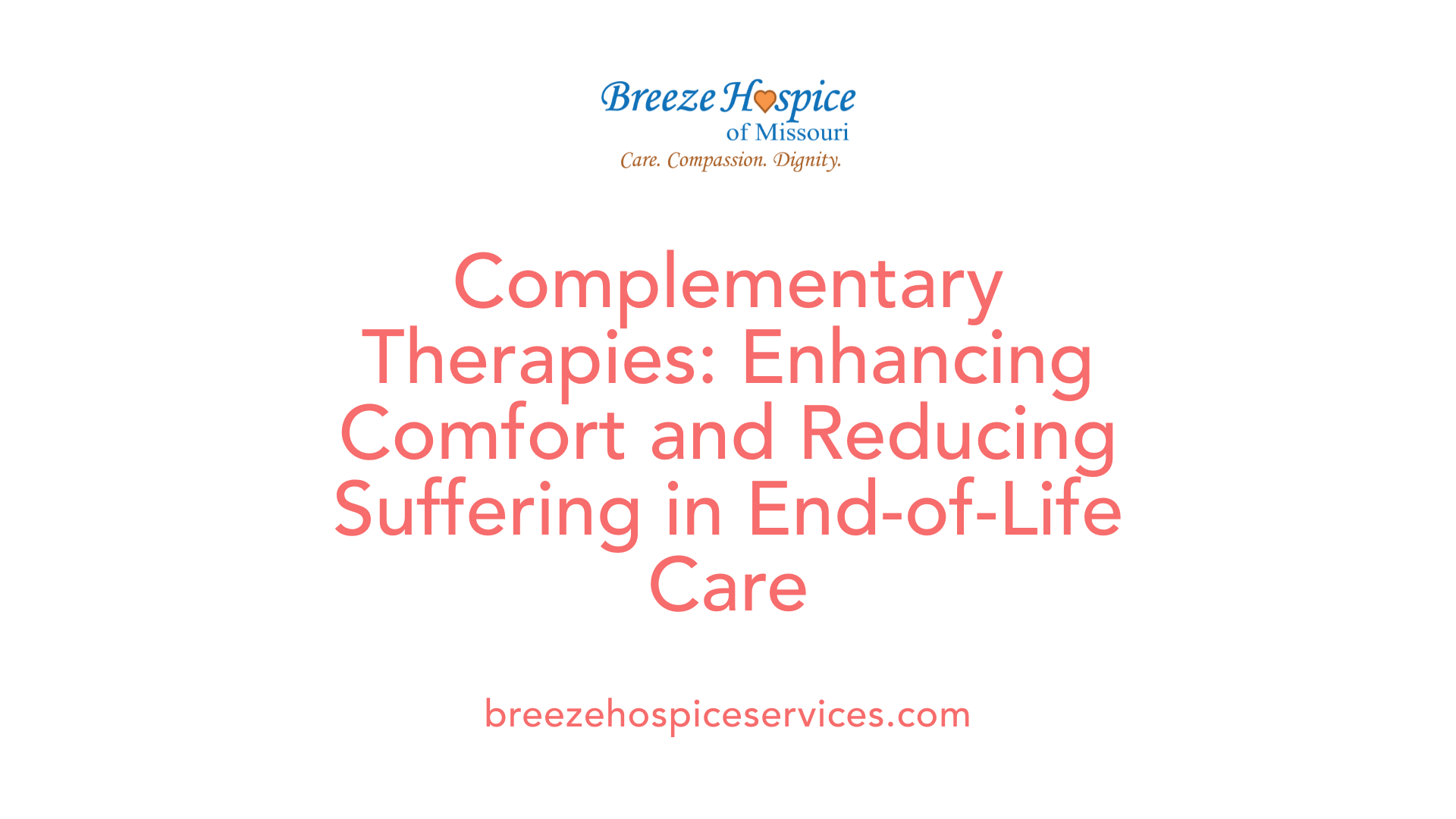Understanding Pain Management in Hospice Care
July 25, 2025
Enhancing Comfort and Dignity at End of Life

Introduction to Pain Management in Hospice Care
Pain management in hospice care is a critical component of providing comprehensive, compassionate support to patients nearing the end of life. It aims to relieve physical suffering, address emotional and spiritual distress, and improve overall quality of life. Despite its vital role, pain and discomfort are often under-recognized and undertreated. Understanding the principles, assessment techniques, medications, and holistic strategies involved in hospice pain management is essential for healthcare providers, patients, and families alike.
Fundamentals and Principles of Hospice Pain Relief

What is the concept of 'total pain' encompassing physical, emotional, interpersonal, and spiritual components?
In hospice care, pain is understood as a complex, multidimensional experience. The idea of 'total pain' emphasizes that suffering at the end of life is not solely a physical sensation but includes emotional distress, social conflicts, and spiritual struggles. These components often intertwine, making pain a personal and holistic experience.
Physical pain may arise from disease processes such as tumor growth or organ failure, which directly activate pain pathways. Emotional components can include anxiety, depression, and grief, which amplify perceptions of discomfort. Interpersonal issues, like conflicts with family or caregivers, may contribute to emotional suffering, while spiritual distress relates to questions of meaning, purpose, or loss of faith.
Addressing each facet of total pain requires a compassionate, multidisciplinary approach. Effective hospice care integrates medical treatment with psychosocial and spiritual support, ensuring that the patient’s overall well-being is nurtured alongside symptom management.
How are guiding principles such as personalized assessment, holistic treatment, and the WHO stepped care approach applied?
The management of pain at the end of life revolves around foundational principles that prioritize patient-centered care. First, personalized assessment involves evaluating the type, location, character, and intensity of pain using validated tools tailored to the patient’s ability to communicate. For non-verbal or cognitively impaired patients, observational scales like the FLACC or Wong-Baker FACES are employed.
Once pain is assessed, a holistic treatment plan is initiated, addressing physical, emotional, social, and spiritual needs. This involves pharmacological therapies, such as opioids and adjuvants, alongside nonpharmacological techniques like massage, music therapy, and spiritual counseling. The goal is to provide symptom relief while respecting the patient’s personal values and preferences.
The WHO stepped care approach provides a structured framework for medication management. It guides clinicians to start with non-opioids (such as acetaminophen and NSAIDs) for mild pain, escalate to weak opioids like tramadol for moderate pain, and progress to strong opioids such as morphine for severe pain. This stepwise method ensures effective pain relief while minimizing side effects.
How is the balance struck between symptom relief with safety and ethical considerations?
Ensuring patient comfort without compromising safety is paramount in hospice pain management. Clinicians aim to relieve suffering ethically by observing principles of beneficence (act in the patient’s best interest), nonmaleficence (do no harm), autonomy (respect patient choices), and justice.
This balance involves careful medication selection, dosing, and ongoing monitoring. While opioids are powerful tools, they require vigilant assessment to prevent adverse effects such as respiratory depression, constipation, or sedation. Physicians titrate medications carefully, use multimodal strategies, and employ adjuvants to minimize reliance on high doses.
Equally vital is transparent communication with patients and families. Educating them about the expected effects, side effects, and safety precautions helps dispel fears—such as the misconception that opioids hasten death or cause addiction. Evidence supports that properly managed opioids improve quality of life and do not shorten lifespan.
In cases of complex symptoms, interdisciplinary teams—including physicians, nurses, social workers, and chaplains—collaborate to craft ethically sound, individualized care plans that honor patient dignity and preferences.
What are some common misconceptions and fears about pain management in hospice care?
Many fears and misconceptions hinder optimal pain management in hospice settings. A prevalent misconception is that opioids will hasten death. While concerns about respiratory suppression exist, when used correctly and titrated carefully, opioids primarily serve to alleviate suffering without significantly affecting lifespan.
Another concern is addiction, which often discourages the use of necessary analgesics. However, in the context of terminal illness, the primary goal is symptom control, and addiction is exceedingly rare, with studies indicating less than 1% of hospice patients develop such issues.
Fears about loss of consciousness or mental clarity also arise, but evidence shows that with proper dosing, opioids do not necessarily impair awareness. In fact, effective pain management can improve mental and emotional well-being.
Misunderstandings about side effects, stigma, and the moral implications of prescribing opioids contribute to hesitancy from patients and families. Education efforts like the EMPOWER program have demonstrated success in addressing these barriers, fostering open communication, and promoting ethical, patient-centered pain relief.
Recognizing and correcting these misconceptions is vital to ensure that patients receive the relief they need, improving comfort, dignity, and the quality of their remaining days.
How do pain assessment tools assist in effective pain management?
Assessment is the cornerstone of effective pain control. Validated scales such as the Numeric Pain Rating Scale (0-10), Wong-Baker Faces Pain Scale, and the FLACC scale facilitate accurate evaluation, especially in patients who cannot communicate verbally.
For instance, the Numeric Scale allows patients to quantify their pain, guiding medication titration. Tools like Wong-Baker FACES use facial expressions to help children or cognitively impaired adults articulate their pain level.
The FLACC scale observes behaviors such as facial expression, leg movement, activity, cry, and consolability, providing an objective measure of pain. Monitoring these signs regularly helps detect hidden or unmanaged pain.
Signs of pain include physiological changes like increased respiratory rate, blood pressure, and body rigidity, as well as behavioral cues such as rocking, fidgeting, withdrawal, vocalizations, or facial grimacing.
Regular reassessment ensures that the treatment plan remains tailored to patient needs, allowing for adjustments in medication or nonpharmacological interventions, thereby maintaining comfort.
What are the pharmacological options guided by the WHO pain ladder?
The WHO pain ladder offers a stepwise approach to pharmacologic pain management. For mild pain, nonsteroidal anti-inflammatory drugs (NSAIDs) like ibuprofen or acetaminophen are utilized first.
When pain persists or worsens, weaker opioids such as tramadol or codeine are introduced for moderate pain. In cases of severe pain, stronger opioids like morphine, fentanyl, oxycodone, or hydromorphone are employed.
Medications can be administered orally, via transdermal patches, injections, IV infusions, or through pumps, as appropriate to patient condition and preference. This flexibility enhances comfort and adherence.
Adjuvant analgesics—including antidepressants, anticonvulsants, corticosteroids, and local anesthetics—play supplementary roles, especially in nerve or bone pain.
Timely escalation and combination of these medications, guided by patient response and side effects, optimize pain relief while maintaining safety.
How are opioids used effectively and what are the considerations?
Opioids such as morphine, oxycodone, fentanyl, hydromorphone, and methadone are mainstays in managing moderate to severe pain in hospice care.
Effective use involves initiating therapy at appropriate doses, titrating carefully to achieve relief while monitoring for adverse effects. Routes of administration include oral, sublingual, transdermal, intravenous, or through pumps—they should be selected based on the patient's condition.
Clinicians must be knowledgeable about equianalgesic dosing and conversion factors to switch opioids safely. Regular assessment helps identify breakthrough pain, which requires additional fast-acting doses.
Common side effects such as nausea, constipation, dry mouth, sedation, and pruritus should be anticipated. Proactive management, like prescribing laxatives for constipation, is essential.
Concerns about addiction are largely unfounded in end-of-life care, provided opioids are used appropriately to control symptoms.
In hospice, opioids are used ethically to maximize comfort, with the understanding that their benefits in alleviating suffering outweigh risks of dependency or hastening death.
What are the roles of complementary and non-pharmacological measures?
Complementary therapies augment medication-based treatment and include massage, music therapy, aromatherapy, guided imagery, heat/cold applications, and acupuncture.
These interventions help reduce anxiety, improve mood, and enhance overall comfort. They are particularly valuable when medication side effects are problematic or when patients prefer non-drug options.
Repositioning, skin care, hydration, and creating a peaceful environment also contribute to pain relief.
Physical modalities like transcutaneous electrical nerve stimulation (TENS) and therapeutic exercises can reduce nerve or musculoskeletal pain.
Psychological support from counselors or spiritual care providers addresses emotional and existential suffering.
The integration of these strategies requires teamwork and respect for patient preferences, providing a comprehensive, tailored approach to end-of-life comfort.
How do the multidisciplinary team and family involvement enhance pain management?
Effective pain control at the end of life depends on collaboration among healthcare professionals, patients, and families. The team typically includes physicians, nurses, social workers, chaplains, and aides.
Regular assessments, transparent communication, and shared decision-making ensure that treatment aligns with patient goals.
Families are educated in medication administration, monitoring signs of pain or side effects, and creating a comforting environment. They are vital partners in evaluating the effectiveness of interventions.
Home visits by providers facilitate ongoing adjustment of care plans, while emotional and spiritual support from counselors and chaplains addresses non-physical aspects of suffering.
This collaborative approach ensures that care is holistic, respectful, and responsive, ultimately enhancing the patient’s quality of life.
What are the safety and ethical considerations in hospice pain management?
Balancing symptom relief with safety involves careful medication selection, appropriate dosing, and vigilant monitoring for adverse effects.
Clinicians follow ethical principles: beneficence (relieving suffering), nonmaleficence (minimizing harm), autonomy (respecting patient choices), and justice (equitable care).
Educating patients and families about medication effects and side effects promotes informed consent and adherence.
Misconceptions about opioids, such as fears of hastening death or addiction, are addressed through evidence-based information, emphasizing that proper use improves quality of life.
Protocols for medication titration, monitoring, and documentation uphold safety and accountability.
In refractory cases, interventions like radiation or surgical procedures are considered, always with a focus on patient dignity and comfort.
In summary, the principles of hospice pain relief revolve around a compassionate, individualized, and ethically grounded approach that addresses all dimensions of pain, ensuring the patient's final days are as comfortable, dignified, and meaningful as possible.
Assessing Pain in End-of-Life Patients

How do healthcare providers assess pain in end-of-life patients?
Assessing pain in patients nearing the end of their lives is a vital step in ensuring effective relief and maintaining comfort. Healthcare providers utilize a combination of validated scales and observational techniques tailored to each patient's communication abilities.
For patients who can communicate verbally, tools like the Numeric Pain Rating Scale (0-10) are standard. This scale allows patients to rate their pain intensity simply, with 0 being no pain and 10 representing the worst imaginable pain. Visual scales such as the Wong-Baker Faces Pain Scale are particularly helpful for children or adults with limited communication skills, enabling them to point to a face that best resembles their pain experience.
Additionally, the FLACC scale (Face, Legs, Activity, Cry, Consolability) is employed when patients are non-verbal or unable to self-report effectively. This observational tool assesses five behavioral categories, providing a score that correlates with pain severity.
Beyond these scales, providers often use multidimensional assessment tools like the Brief Pain Inventory (BPI) or the McGill Pain Inventory. These instruments delve into the nature of pain—descriptors, location, and influence on function—offering a comprehensive picture essential for tailored management.
In non-communicative patients, behavioral cues become especially important. Signs such as grimacing, furrowing of the brow, restlessness, vocalizations, or resistance to care can indicate underlying pain. Input from family members or caregivers, who observe the patient day-to-day, also plays a crucial role, providing insights into subtle changes that might suggest discomfort.
Ongoing, regular reassessments are critical. Pain levels can fluctuate, especially with disease progression or treatment adjustments. Continuous monitoring ensures that care strategies remain effective and patient comfort is maximized. Ultimately, pain assessment in end-of-life care is a personalized, multidimensional process integrating clinical tools, patient communication, and interdisciplinary observations.
This diligent evaluation guides healthcare teams to optimize pain management strategies, balancing medication, non-pharmacological therapies, and emotional support, thereby enhancing quality of life during this sensitive stage.
Pharmacological Strategies and Medication Use

How does the WHO ladder guide medication escalation in hospice pain management?
The World Health Organization (WHO) developed a stepwise approach—known as the WHO pain ladder—to effectively manage pain in hospice patients. It starts with non-opioid analgesics such as acetaminophen or NSAIDs for mild pain. When pain intensifies, weak opioids like tramadol or codeine are added for moderate pain control. For severe or unrelieved pain, strong opioids such as morphine, oxycodone, fentanyl, hydromorphone, or methadone are employed. This graduated approach ensures appropriate medication intensity, minimizes side effects, and tailors treatment to individual needs.
What medications are used for pain relief in hospice care, and what are their safety considerations?
Hospice care relies on a spectrum of medications to alleviate pain and improve quality of life. Commonly used drugs include:
| Medication | Usage | Route of Administration | Safety and Side Effect Management |
|---|---|---|---|
| Acetaminophen | Mild pain | Oral, rectal | Liver toxicity at high doses; monitor liver function. |
| NSAIDs | Mild to moderate pain | Oral, IV | Risk of kidney damage, gastrointestinal bleeding; use cautiously in at-risk patients. |
| Morphine | Moderate to severe pain | Oral, IV, subcutaneous, transdermal | Constipation, nausea, sedation, respiratory depression; proactive management with laxatives, antiemetics, and close monitoring. |
| Oxycodone | Moderate to severe pain | Oral | Similar side effects as morphine; dose titration required. |
| Fentanyl | Severe pain, rapid onset | Transdermal patches, IV, sublingual | Risk of accumulation, requires careful conversion and dosage adjustment. |
| Hydromorphone | Severe pain, potent choice | Oral, IV, subcutaneous | Increased potency with similar side effects as morphine; careful titration. |
| Methadone | Opioid-refractory pain, complex cases | Oral, IV, subcutaneous | Long half-life; risk of accumulation leading to respiratory depression; requires specialized knowledge for dosing. |
Safety considerations include regular assessment for side effects such as constipation, nausea, sedation, and respiratory depression. Management strategies include administering laxatives preemptively, using anti-nausea medications, and continuous respiratory monitoring. The use of adjuvant therapies, as well as psychosocial support, complements pharmacological management.
Routes of administration and their roles
Medications can be delivered through various routes to enhance comfort and compliance:
- Oral: Most common, easy to administer.
- IV and subcutaneous: For rapid onset, especially when oral intake is compromised.
- Transdermal patches: Provide continuous medication delivery, suitable for persistent pain.
- Infusions and pumps: For controlled dosing and breakthrough pain management.
Careful selection of the route depends on the patient's condition, preference, and the pharmacokinetics of the medication.
Managing side effects effectively
Side effects such as constipation require proactive measures like laxatives. Nausea can be mitigated with antiemetics. Sedation usually diminishes over time but requires dose adjustments if excessive. Respiratory depression, a serious concern, is rare with proper titration and monitoring.
Overall, individualized medication plans, vigilant assessment, and multidisciplinary management are vital to optimize pain relief while minimizing risks. Continuous education for patients and caregivers about medication use and side effect management further supports safe, effective hospice care. Tools like equianalgesic charts assist clinicians in switching opioids safely and adjusting doses appropriately.
Through this comprehensive and cautious approach, palliative teams aim to provide compassionate relief, respecting the patient's dignity and enhancing their remaining quality of life.
Holistic and Supportive Therapies in Pain Management

How do holistic and supportive therapies play a role in hospice pain management?
Holistic and supportive therapies are fundamental components of comprehensive pain management in hospice care. They target the whole person—physical, emotional, spiritual, and psychological—fostering a sense of peace and well-being.
Complementary interventions like massage, acupuncture, aromatherapy, music therapy, pet therapy, and guided imagery are increasingly incorporated into standard protocols to reduce pain and anxiety. For example, massage therapy helps relax tense muscles, decrease stress, and improve circulation, which can lessen discomfort.
Acupuncture has been shown to modulate pain signals and promote relaxation, while aromatherapy uses essential oils to soothe the senses and alleviate tension. Music therapy provides emotional comfort by distracting patients from pain, reducing stress, and improving sleep patterns.
Biofield therapies such as reiki aim to balance energy fields, contributing to relaxation and pain relief. Pet therapy offers emotional solace and companionship, reducing feelings of loneliness and depression.
These holistic practices not only decrease the perception of pain but also reduce other distressing symptoms like dyspnea and agitation. They promote relaxation, enhance sleep quality, and lower muscle tension, which can translate into less reliance on pharmacologic pain control.
The integration of these therapies requires personalized care plans tailored to patient preferences and responses. They are used as adjuncts alongside medications, not replacements, to create a multidimensional approach to comfort.
Evidence suggests that when combined with conventional treatment, holistic therapies can significantly enhance quality of life. Patients often report feeling more emotionally supported, less anxious, and better able to find peace during their final days.
While there is positive anecdotal and preliminary scientific support, ongoing research aims to standardize protocols and determine optimal combinations to ensure consistency and effectiveness across hospice settings.
In summary, holistic and supportive therapies play an essential role by addressing the diverse needs of patients, helping to alleviate suffering, and promoting dignity and comfort in end-of-life care.
The Role of Families and Caregivers
How can families and caregivers support effective pain management at the end of life?
Families and caregivers play a vital role in ensuring pain and discomfort are managed effectively during hospice care. Their support begins with maintaining open and honest communication with healthcare teams. This collaboration helps in tailoring treatment plans, including medication adjustments, and ensures that the patient's changing needs are promptly addressed.
Helping with medication administration is crucial. Caregivers should learn proper medication techniques, observe for side effects or signs of pain, and report any concerns to the hospice team. Monitoring symptoms closely allows for timely interventions, helping maintain optimal comfort levels.
In addition to physical care, creating a calming environment can significantly improve the patient’s emotional well-being. Simple measures such as adjusting lighting, playing soothing music, and ensuring a comfortable, peaceful setting help reduce anxiety and promote relaxation.
Advocacy for the patient’s preferences and comfort is essential. Caregivers should ensure the patient's wishes regarding pain control and overall care are respected and communicated to the healthcare team.
Supporting emotional and psychological health is equally important. Active listening, reassurance, and presence help alleviate feelings of fear, loneliness, or distress. Engaging spiritual care providers or social workers can provide additional emotional support.
Practical support, like assisting with daily activities—such as repositioning, personal hygiene, and gentle massage—can also relieve physical discomfort and foster a sense of security.
It’s important for caregivers to recognize their limits and seek support when needed. Caregiver self-care ensures they remain capable of providing compassionate, sustained support. Participating in caregiver support groups or seeking respite care can help manage stress and prevent burnout.
In sum, families and caregivers are instrumental in the holistic approach to pain management at the end of life. Their active involvement, grounded in empathy, communication, and advocacy, enhances comfort and dignity for the patient.
Supporting medication administration and monitoring symptoms
Proper medication management by families involves understanding medication schedules, safe storage, and recognizing signs of peaks or adverse effects. Using pill organizers, keeping medication logs, and following the prescribed regimen help ensure consistency.
Monitoring symptoms includes observing behavioral cues and physical signs of pain, such as grimacing, restlessness, changes in breathing, or withdrawal. Using validated scales like the Numeric Pain Rating Scale or observing non-verbal indicators enables caregivers to provide accurate updates.
Maintaining open communication with healthcare teams
Regular updates and questions foster a partnership that prioritizes patient comfort. Caregivers should communicate any concerns about medication effectiveness, side effects, or new symptoms promptly.
Creating a calming environment
Adjusting room lighting, minimizing noise, and incorporating familiar or comforting objects helps create a peaceful space conducive to relaxation.
Advocating for patient comfort and preferences
Caregivers must voice the patient’s wishes regarding pain relief and care preferences, ensuring these are honored within the scope of medical guidance.
Understanding and managing emotional and psychological support
Providing reassurance, engaging in calming activities, and involving spiritual or mental health support help address the emotional facets of pain and distress, contributing to an improved quality of life.
Impact of Pain Management on Quality of Life and Dignity
How does pain management impact patient quality of life and comfort during end-of-life care?
Effective pain management is fundamental in enhancing the overall experience of patients in hospice and palliative care. It primarily aims to relieve physical suffering caused by the illness, but it also addresses the emotional and spiritual components of "total pain," a comprehensive concept that includes psychological, social, and existential distress.
By employing a combination of pharmacological treatments—such as opioids, NSAIDs, and adjuvant medications—alongside nonpharmacological approaches like repositioning, massage, music therapy, and counseling, healthcare providers can substantially mitigate pain and discomfort. This integrated approach not only alleviates physical symptoms but also reduces associated anxiety, depression, and feelings of helplessness.
Hospice teams tailor pain relief strategies to each patient's unique needs, providing education to patients and families about medication use, side effect management, and the importance of timely reporting of pain. This collaborative, patient-centered approach promotes a sense of control and dignity.
Evidence demonstrates that effective pain control results in improved symptom scores across multiple domains, including mental health, mood, and activity levels. Patients often report feeling more comfortable, autonomous, and supported, which contributes greatly to their overall quality of life.
Reducing the intensity and frequency of pain helps prevent unnecessary hospital visits and invasive procedures, allowing patients to spend their remaining days in familiar and comforting environments. Moreover, good pain management fosters a peaceful and meaningful end-of-life experience, where patients can focus on personal reflection, spiritual connection, and meaningful interactions with loved ones.
By prioritizing holistic pain relief, hospice care not only alleviates suffering but also upholds the dignity and autonomy of patients as they approach the final phases of life. This compassionate approach ensures that patients experience the highest possible quality of remaining life, emphasizing comfort, respect, and personal values during this profound stage.
Developing Individualized Pain Management Plans
How do healthcare providers develop personalized pain management plans?
Creating effective pain management strategies for hospice patients requires a thorough and personalized approach. Healthcare providers begin with a comprehensive assessment that involves understanding the specific type, location, and intensity of the patient’s pain. They use validated assessment tools such as numeric pain rating scales, Wong-Baker Faces, or specialized scales for non-verbal patients like those with dementia. This detailed evaluation includes observing behavioral signs — such as grimacing, body stiffness, or agitation — and collecting patient self-reports.
Beyond evaluating pain, clinicians take into account the patient's medical history, current medications, lifestyle, and psychosocial circumstances. This holistic view helps identify potential triggers, coping mechanisms, and psychological factors influencing pain. Patients’ personal goals and preferences are also crucial in designing a plan that aligns with their values, whether that involves maintaining independence, reducing suffering, or enhancing comfort.
A multidisciplinary team approach is fundamental. The team typically includes doctors, nurses, social workers, spiritual advisors, and physical or occupational therapists. This collaborative effort combines pharmacologic treatments—such as opioids or adjuvants—with non-pharmacologic interventions like massage, relaxation techniques, and acupuncture. Such integration ensures that every dimension of the patient's experience is addressed.
Adherence to evidence-based guidelines, such as the WHO stepwise approach for pain relief, helps structure the treatment plan. Regular monitoring and ongoing communication are essential to assess the effectiveness of interventions and side effects. Clinicians adjust medications—whether increasing doses, switching drugs, or incorporating new therapies—as the patient’s condition evolves.
Advances in technology further enhance tailored care. Telemedicine consultations, wearable devices that monitor activity or pain levels, and genetic testing for drug metabolism can provide deeper insights, allowing clinicians to customize treatments more precisely. Ultimately, the goal is to craft a flexible, patient-centered plan that maximizes comfort, supports emotional well-being, and respects the patient’s wishes at every stage of end-of-life care.
Guidelines and Optimization of Pain Control
Are there specific guidelines for hospice pain management?
Yes, hospice care employs specific, evidence-based guidelines to ensure effective pain relief while safeguarding patient safety. These guidelines prioritize a comprehensive assessment, individualization of treatment, and continuous monitoring.
Hospice pain management guidelines recommend regular evaluation of pain using validated tools like the Numeric Pain Rating Scale (0-10), Wong-Baker Faces Pain Scale, or FLACC scale for non-verbal patients. This ongoing assessment helps tailor treatment plans to current needs and respond promptly to changes.
The approach follows the World Health Organization (WHO) step-care model. This model advocates starting with nonsteroidal anti-inflammatory drugs (NSAIDs) or acetaminophen for mild pain, progressing to weak opioids such as tramadol for moderate pain, and escalating to strong opioids like morphine, fentanyl, or oxycodone for severe pain. Medications are administered through various routes—including oral, transdermal, subcutaneous, or intravenous—to optimize efficacy and comfort.
Non-drug measures like repositioning, skin care, hydration, and spiritual or emotional support are integrated into care plans. These interventions, along with pharmacological therapies, help in achieving a holistic approach.
Special attention is given to managing side effects such as constipation, nausea, sedation, and respiratory depression. Using equianalgesic charts aids in converting doses when switching between opioids, ensuring safe titration.
A multidisciplinary team — including physicians, nurses, social workers, chaplains, and patient families — collaborates closely. This teamwork emphasizes patient-centered care, enhances communication, and promotes shared decision-making.
Patient and family education is a cornerstone of effective pain management. Families are taught about medication use, managing side effects, recognizing signs of breakthrough pain, and maintaining safety measures like proper storage.
The goal of these guidelines is to maximize comfort, improve quality of life, and uphold dignity at the end of life. They provide a structured framework that is adaptable to the unique needs of each patient, ensuring that pain and associated symptoms are managed proactively and compassionately.
Final Thoughts on Compassionate End-of-Life Care
Effective pain management in hospice care is a cornerstone of providing dignity, comfort, and quality of life during a patient’s final days. It involves a holistic approach that combines accurate assessment, personalized medication strategies, supportive therapies, and compassionate communication. Addressing the physical, emotional, social, and spiritual aspects of pain ensures that patients experience relief from suffering and maintain their dignity. Ongoing education, interdisciplinary teamwork, and active involvement of families are essential components that enhance the effectiveness of pain control. Dispelling misconceptions about opioids and emphasizing ethical, patient-centered care are vital to overcoming barriers and ensuring that every patient receives the comfort they deserve. Ultimately, the goal is to create a peaceful, respectful, and meaningful end-of-life experience that honors each individual’s wishes and human dignity.
References
- End-of-Life Evaluation and Management of Pain - StatPearls - NCBI
- All You Need to Know About Hospice Pain Management
- Palliative Care Methods for Controlling Pain | Johns Hopkins Medicine
- Hospice Pain Management - Samaritan NJ
- Hospice and Pain Management | VITAS Healthcare
- The Importance of Pain Control During End-of-Life Care
- End-of-Life Pain Management for Hospice Patients - Amedisys
- Managing Pain in the Dying Patient - AAFP
- Hospice: The Importance of Managing Pain - Saint Luke's
- Hospice Pain Management: A Compassionate Guide



































































































